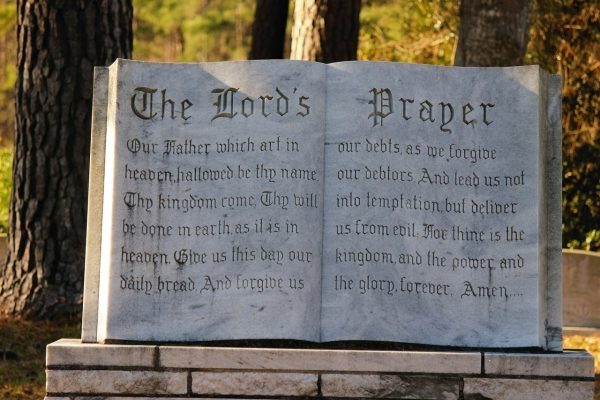Home>Christian Videos>Bible Stories>Which Gospels Have The Lords Prayer


Bible Stories
Which Gospels Have The Lords Prayer
Published: March 7, 2024
Peter Smith, Editorial Director at Christian.net, combines deep insights into faith, politics, and culture to lead content creation that resonates widely. Awarded for his contributions to religious discourse, he previously headed a major organization for religious communicators, enhancing dialogue on faith's societal impacts.
Discover which gospels contain the Lord's Prayer and explore its significance in the Bible stories. Uncover the origins and meanings of this iconic prayer.
(Many of the links in this article redirect to a specific reviewed product. Your purchase of these products through affiliate links helps to generate commission for Christian.net, at no extra cost. Learn more)
Table of Contents
Introduction
The Lord's Prayer is one of the most well-known and widely recited prayers in Christianity. It holds significant importance for believers and is often recited during religious services, personal prayer, and even in times of distress. However, not many people are aware of the fact that the Lord's Prayer is found in different versions in the Gospels of the New Testament. This article will explore which Gospels contain the Lord's Prayer and the variations that exist within them. Let's delve into the Gospels to uncover the presence of this cherished prayer.
Read more: 10 Verses About The Lord’s Prayer
The Lord's Prayer in the Gospel of Matthew
The Gospel of Matthew, one of the four canonical Gospels, contains the most well-known version of the Lord's Prayer. It is found in the New Testament, specifically in Matthew 6:9-13. In this rendition, Jesus teaches his disciples how to pray, emphasizing the importance of addressing God as "Our Father." The prayer serves as a model for the disciples and subsequent generations of Christians, outlining key elements of prayer, including acknowledging God's holiness, seeking His will, asking for daily provisions, seeking forgiveness, and requesting deliverance from temptation and evil. The Lord's Prayer in the Gospel of Matthew is a cornerstone of Christian worship and spiritual practice, reflecting the teachings and emphasis on prayer within the Christian tradition.
Key Points:
- The Lord's Prayer in the Gospel of Matthew is found in Matthew 6:9-13.
- It serves as a model for prayer, emphasizing the acknowledgment of God as "Our Father" and covering key aspects of prayer.
- The prayer's presence in the Gospel of Matthew underscores its significance as a foundational element of Christian faith and practice.
The Lord's Prayer in the Gospel of Luke
In the Gospel of Luke, the Lord's Prayer is presented in a slightly different context compared to Matthew's Gospel. It is located in Luke 11:1-4, where Jesus' disciples ask him to teach them how to pray, mirroring the disciples' request in Matthew's Gospel. The version in Luke is shorter than the one in Matthew, with a focus on brevity and clarity. The prayer emphasizes the sanctification of God's name, the coming of His kingdom, the provision of daily bread, the forgiveness of sins, and deliverance from temptation. This concise yet profound rendition of the Lord's Prayer in the Gospel of Luke highlights the universal and timeless nature of its message, encapsulating the essence of Christian devotion and reliance on God. The presence of the Lord's Prayer in the Gospel of Luke reinforces its significance as a fundamental aspect of Christian spirituality and communal worship.
Key Points:
- The Lord's Prayer in the Gospel of Luke is found in Luke 11:1-4.
- It is presented in a more concise manner compared to the version in Matthew's Gospel.
- The prayer emphasizes the sanctification of God's name, the coming of His kingdom, the provision of daily bread, the forgiveness of sins, and deliverance from temptation.
- Its presence in the Gospel of Luke underscores its enduring relevance and universal appeal within the Christian faith.
Read more: 20 Versions Of The Lord’s Prayer
The Lord's Prayer in the Gospel of Mark
The Gospel of Mark, although not containing the full version of the Lord's Prayer, provides valuable insights into Jesus' teachings on prayer. Unlike Matthew and Luke, the Gospel of Mark does not explicitly present the Lord's Prayer as a distinct unit of teaching. However, it does offer glimpses of Jesus' emphasis on prayer and the essential elements encapsulated in the Lord's Prayer. Mark 11:25, for example, records Jesus' instruction on forgiveness during prayer, stating, "And whenever you stand praying, forgive, if you have anything against anyone, so that your Father also who is in heaven may forgive you your trespasses." This emphasis on forgiveness aligns with the themes of forgiveness and reconciliation present in the Lord's Prayer, highlighting the interconnectedness of Jesus' teachings on prayer across the Gospels.
While the Gospel of Mark may not feature the complete Lord's Prayer, its inclusion of Jesus' teachings on forgiveness and prayer underscores the overarching significance of prayer within the Christian faith. Mark's portrayal of Jesus as a model of prayer and his emphasis on forgiveness as a vital component of prayer align with the broader themes encapsulated in the Lord's Prayer, contributing to the holistic understanding of prayer within the Christian tradition.
In summary, although the Gospel of Mark does not contain the full rendition of the Lord's Prayer, its inclusion of Jesus' teachings on forgiveness and prayer provides valuable complementary insights to the themes encapsulated in the prayer. Mark's portrayal of Jesus as a teacher of prayer and his emphasis on forgiveness align with the foundational principles embedded in the Lord's Prayer, enriching the overall understanding of prayer within the Christian context.
The Lord's Prayer in the Gospel of John
The Gospel of John, unlike the synoptic Gospels of Matthew, Mark, and Luke, does not contain a specific instance where Jesus teaches the Lord's Prayer to his disciples. However, the Gospel of John does encompass themes and teachings that resonate with the essence of the Lord's Prayer. John 17, often referred to as the "High Priestly Prayer" or the "Farewell Prayer of Jesus," presents a profound and intimate dialogue between Jesus and the Father. While not identical to the Lord's Prayer found in the synoptic Gospels, this prayer encapsulates the core elements of the Lord's Prayer, such as the sanctification of God's name, the unity of believers, and the desire for God's will to be fulfilled.
In John 17:1-26, Jesus prays for himself, his disciples, and all future believers, expressing his longing for unity among his followers and the glorification of God through their unity. This prayer reflects the interconnected themes of God's sovereignty, the sanctification of his name, and the unity of believers, which are fundamental aspects of the Lord's Prayer. While not presented in the traditional format of the Lord's Prayer, the depth and spiritual significance of Jesus' prayer in the Gospel of John resonate with the foundational principles encapsulated in the Lord's Prayer.
The absence of a direct recitation of the Lord's Prayer in the Gospel of John does not diminish the spiritual and theological richness found in Jesus' dialogue with the Father. Instead, it offers a unique perspective on the themes of divine intimacy, unity, and the fulfillment of God's purposes, which are intricately woven into the fabric of the Lord's Prayer. The Gospel of John's portrayal of Jesus' profound communion with the Father and his intercession for his followers complements and enriches the broader understanding of prayer within the Christian tradition, emphasizing the timeless and universal relevance of the Lord's Prayer across the Gospels.
Conclusion
In conclusion, the Lord's Prayer holds a significant place within the Gospels of the New Testament, with variations and complementary teachings found in the books of Matthew, Luke, Mark, and John. The Gospel of Matthew presents the most comprehensive version of the Lord's Prayer, emphasizing its role as a model for Christian prayer and spiritual devotion. The Gospel of Luke offers a concise yet profound rendition, highlighting the universal and timeless nature of its message. While the Gospel of Mark does not contain the full version of the prayer, it provides valuable insights into Jesus' teachings on forgiveness and prayer, complementing the themes of the Lord's Prayer. The Gospel of John, although not featuring a direct recitation of the Lord's Prayer, presents a profound dialogue between Jesus and the Father, encapsulating the core elements and spiritual significance of the prayer. Collectively, the presence and teachings surrounding the Lord's Prayer in the Gospels underscore its enduring relevance and universal appeal within the Christian faith, enriching the spiritual understanding and practice of prayer for believers across generations.














